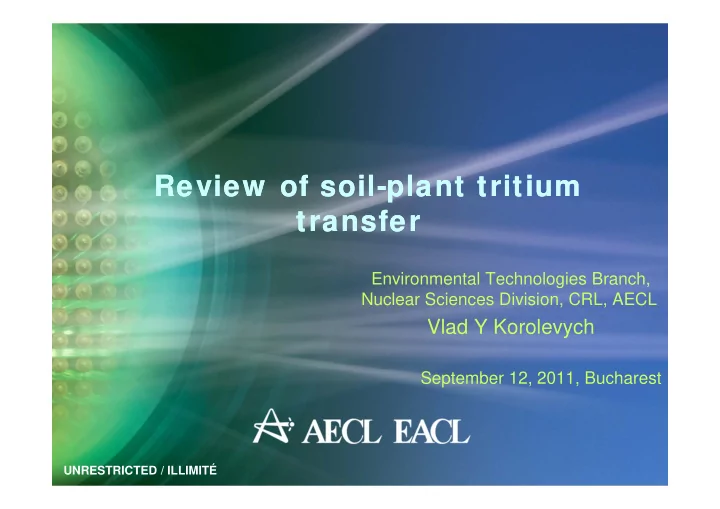

Review of soil-plant tritium Review of soil-plant tritium transfer transfer Environmental Technologies Branch, Nuclear Sciences Division, CRL, AECL Vlad Y Korolevych September 12, 2011, Bucharest UNRESTRICTED / ILLIMITÉ
Summary of past tritium experiments 1. Tritium (HTO) moves with water and follows water cycle in soil-plant-atmosphere system. 2. HTO diffuses on its own according to the concentration gradient. 3. By BOTH of this pathways HTO gets into vegetation (leaves) and is bound into OBT by photosynthesis. MODELS 1. GAZAXI 2. ETMOD 3. UFOTRI …. 11. SOLVEG-II UNRESTRICTED / ILLIMITÉ 2
Issue Variability makes model validation limited and universal applicability of existing models appears only at a cost of high uncertainties UNRESTRICTED / ILLIMITÉ 3
Issue Variability makes model validation limited and universal applicability of existing models appears only at a cost of high uncertainties Variability pertaining to soil-plant interaction comprises of: – Spatial (soils, land use, etc.) – Temporal (meteo-forcings) – Inter-species/cultivar UNRESTRICTED / ILLIMITÉ 4
Objective Provide the overview of capabilities of existing models of tritium transfer in soil- plant system and outline the approach to spatial variability. UNRESTRICTED / ILLIMITÉ 5
Processes in soil-plant system 1. Water Infiltration (HTO advection): – Storm (e.g. Green-Ampt, numerical Richards) – Free (Darcian flow) 2. Root uptake via plant transpiration 3. Diffusion of HTO UNRESTRICTED / ILLIMITÉ 6
Processes in soil-plant system 1. Water Infiltration (HTO advection): – Storm (e.g. Green-Ampt piston, numerical Richards) – Free (Darcy flow) 2. Root uptake via plant transpiration 3. Diffusion of HTO (2 phase) 4. Soil Thermodynamics UNRESTRICTED / ILLIMITÉ 7
Boundary conditions for HTO 1. Independent surface gaseous deposition 2. Rainfall and dew-fall (assisted transport to soil) 3. Re-emission (independent loss to atmosphere according to gradient of concentration) 4. Evaporation-assisted transport to atmosphere 5. Drainage to aquifer (recharge/discharge) UNRESTRICTED / ILLIMITÉ 8
Model Capabilities • GAZAXI: B.cond.: wet (Chamberlain), dry - gradient exchange by Vex~LAI; Processes: root uptake via ET=const • ETMOD: B.cond.: only dry dep. (Vex. by resistance approach); Processes: root uptake via ET (resistance approach), Diffusion and infiltration – semi-analytical (bottom - no flow), • UFOTRI: B.cond.: wet (scavenging coeff), dry (Vex. by resistance approach), re-emission ~ ET (Monteith) ; Processes: root uptake via ET (Monteith), infiltration – matrix force (suction tension, h. conductivity, bottom - no flow); • SOLVEG-II: B.cond.: wet (scavenging coeff), mixed b.c. (Vex., carbon-modelled stom. resistance), re-emission independently via Vex and carbon-based ET; Processes: Soil thermodynamics, CO2 diffusion, 2-phase HTO diffusion and advection (1-phase Richards for water) UNRESTRICTED / ILLIMITÉ 9
Soil-atmosphere coupling and sfc. fluxes spatial variability Example based on topography. Soil texture can have the same effect and either multiply or cancel this out Uncoupled Strong Surface fluxes and coupling water table depths: Uncoupled UNRESTRICTED / ILLIMITÉ 10
HTO re-emission: The need for sensitivity tests Uncoupled Strong Surface fluxes and coupling water table depths: Uncoupled UNRESTRICTED / ILLIMITÉ 11
HTO re-emission: The need for sensitivity tests Uncoupled Strong Surface fluxes and coupling water table depths: Uncoupled UNRESTRICTED / ILLIMITÉ 12
Adjustment of existing models LH/SH partitioning Water supply favours ET limited (ET approaches* conductance g c potential ET) and ET _____________ *) with correction of wet stomatal blocking Uncoupled Strong Surface fluxes and coupling water table depths: Leaking Bucket, free drainage, etc. Uncoupled soil TD could Bucket model, matter capillary rise UNRESTRICTED / ILLIMITÉ 13
Addressing spatial variability • Sensitivity analysis of HTO re-emission • Mapping DEM to soil texture • GIS-based parameterization of HTO re- emission in each grid-cell using a combination of water-limited and water-unlimited HTO re- emission UNRESTRICTED / ILLIMITÉ 14
Example 1: w et conditions UNRESTRICTED / ILLIMITÉ 15
Example 2: transient conditions, experiment UNRESTRICTED / ILLIMITÉ 16
Example 3: transient conditions, model UNRESTRICTED / ILLIMITÉ 17
Conclusions •Existing models are adequate but not universally applicable (if we are after narrow uncertainties) •Spatial variability of HTO re-emission could be addressed by combination of models in wet and dry conditions •Sensitivity study is required for critical zone of strong atmosphere-soil coupling •Sensitivity to spatial variability should be compared to cultivar variability UNRESTRICTED / ILLIMITÉ 18
THANK YOU UNRESTRICTED / ILLIMITÉ 19
Recommend
More recommend